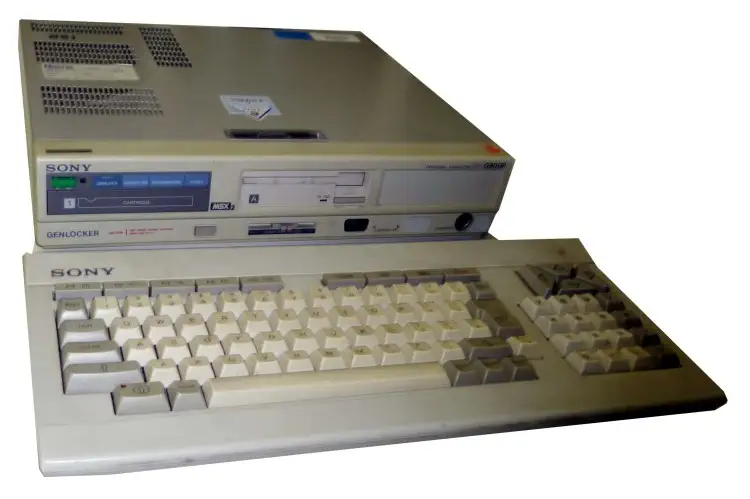Sony HitBit F900P MSX2 with Genlock
The HB-G900P is a 1985 Sony MSX2 personal computer system which focused on the business and professional markets. The computer features a Genlock and superimpose function for external video and can be used together with the SOny Lasermax LaserVision LDP-1500P Video Disc Player.
The computer has a built-in floppy drive, two cartridge slots one at the front and rear. The separate keyboard is also equipped with a numeric keypad and cursor keys. The HG-900P is equipped with a Genlock module to combine images from the MSX2 VDP and an external video input. The MSX2 BASIC has been expanded with a extra instructions for controlling the laser disc player and the GenLock module.



The MSX2 Standard was introduced as successor to the MSX standard. The biggest improvement on the standard were the video capabilities of the system. Where the MSX-1 was quite capable with 16 colors and hardware sprites, it had some limitations. The graphics mode was pattern based, which meant that pixels were grouped by the 8, and each 8 pixels could only have one foreground and one background color. For games and pictures this meant that there was a color spill effect, colors bleeding over in unwanted areas.
The MSX2 introduced a new Video Display Processor, the V9938. This chip had the capacity to display 256 color simultanously, or have graphics modes with 16 colors out of a 512 color palette. It had true bitmapped graphics, that offered multiple in-memory pages for double buffering or vertical scrolling. The sprite system now supported multi-color sprites, and up to 8 sprites per scan-line. The Video RAM was defined to be at least 64KByte, but most systems came with 128KByte which was the maximum the V9938 supported.
The V9938 made it possible to create some great games. The most famous is the very first version of Konami's excellent game Metal Gear.
MSX Cassette Pin Layout
The MSX Standard calls for all MSX computers to have a standard data-cassette port. This port transports the audio-in/out signals to and from the datarecorder and the computer has a relay-switch on board to turn the recorder on and off.

MSX Cartridge Connector
The MSX Cartridge system uses a 50-pin flat-edge connector to connect to the systems expansion bus. The cartridge slot maps into one of the main- or sub-slots.
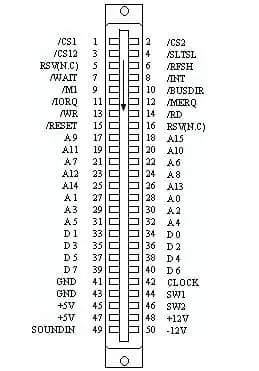
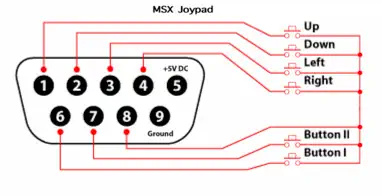
V9938 Video Display Processor
The V9938 is a video display processor developed by Yamaha. It is mainly used on MSX2 computers, but also in teh Tatung Einstein 256 and the Geneve 9640 enhanced TI-99/4A clone. Some MSX-1 computers used it with 16kByte of memory to enable a 80 column text display
Specifications:
- Video RAM: 16-192 KByte
- Text mdoes: 80x24, 40x24, 32x24 (with sprite capability and multi-color)
- Graphics: 512x212 (16 colors from 512), 256x212(16 colors from 512) and 256x212 in 256 colors
- Sprites: 32 sprites, 16 colors (2 per line), 8 sprites per scanline
- Hardware Accelleration for copy, line, fill and logical operations
- Interlacing for doubling of resolution
- Vertical scroll register
- Clock: 21 MHz
- Superposition and digitization capabilities
- Video Output: 15 kHz
- Support for lightpen and mouse<
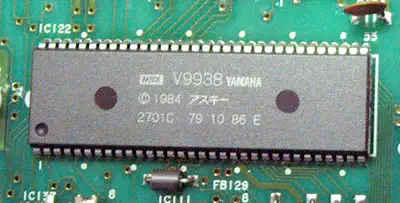
Programmable Sound Generator (AY-3-8910 compatible PSG)
The AY-3-8910 is a 3-voice Programmable Sound Generator, or PSG. It was designed by General Instrumet in 1978 for use with their own 8-bit PIC1650 and their 16-bit CP1610 computers.
The PSG is widely used in many arcade cabinets, pinball machines, and many micro-computers. Here is a list of some of the major brands of computer that used the AY-3-8910:
- Intellivision
- Vectrex
- Amstrad CPC range
- Oric-1
- Color Genie
- Elektor TV Games Computer
- All MSX-1 and MSX-2 computers
- ZX Spectrum home computers
General Instrument spun of MicroChip Technology in 1987 and the chip was sold under the MicroChip brand, and licensed to Yamaha as the YM2149F which the Atari ST range of computers use. Functionally the PSG is very similar to the Texas Instruments SN76489.
Variants:
-
AY-3-8910
Comes with 2 general purpose 8-bit parallel I/O ports, used for Keyboard and Joystick in for instance MSX. -
AY-3-8912
Same chip, but in a 28-pin package. Parallel port B is not connected to save cost and space. -
AY-3-8913
Same chip, but in a 24-pin package. Both parallel ports are not connected. -
AY-3-8914
The AY-3-8914 has the same pinout and is in the same 40-pin package as the AY-3-8910, except the control registers on the chip are shuffled around, and the 'expected input' on the A9 pin may be different. It was used in Mattel's Intellivision console and Aquarius computer. -
AY-3-8930
Backwards compatible but BC2 pin is ignored
YM2149F -
YM3439-D
CMOS version of the Y2149 in 40-pin DIP -
YM3439-F
CMOS version of the Y2149 in 44-pin QFP -
YMZ294
Variant of the YM3249 in an 18-pin package. Parallel ports not connected, and all sound channels mixed on 1 port. -
T7766A
Toshiba variant of the AY-3-8910, fully compatible. Used in some MSX models. - Winbond WF19054, JFC95101, and File KC89C72: Fully compatible versions of the AY-3-8910 produced for slot machines.
Yamaha Produced chip, same pin-out as the AY-3-8910, but pin 26 could halve the master clock. Can be used to replace the AY-3-8910 if pin 26 is left disconnected.
Zilog Z80 CPU Family
The Z80 quickly became popular in the personal computer market, with many early personal computers, such as the TRS-80 and Sinclair ZX80, using the Z80 as their central processing unit (CPU). It was also widely used in home computers, such as the MSX range, SORD, and the Amstrad CPC, as well as in many arcade games. Additionally, it was also used in other applications such as industrial control systems, and embedded systems. The Z80 was widely used until the mid-1980s, when it was gradually replaced by newer microprocessors such as the Intel 80286 and the Motorola 68000.
The Z80 microprocessor was developed by Zilog, a company founded by Federico Faggin in 1974. The Z80 was released in July 1976, as a successor to the Intel 8080. It was designed to be fully compatible with the 8080, but also included new features such as an improved instruction set, more powerful interrupts, and a more sophisticated memory management system.
The Z80 quickly became popular in the personal computer market, with many early personal computers, such as the TRS-80 and Sinclair ZX80, using the Z80 as their central processing unit (CPU). It was also widely used in home computers, such as the MSX range, SORD, and the Amstrad CPC, as well as in many arcade games. Additionally, it was also used in other applications such as industrial control systems, and embedded systems. The Z80 was widely used until the mid-1980s, when it was gradually replaced by newer microprocessors such as the Intel 80286 and the Motorola 68000. The design was licensed to Synertek and Mostek as well as the European SGS.
The Z80s instruction set is binary compatible with the Intel 8080, so that 8080 code such as the CP/M Operating System and Intel's PL/M compiler for the 8080 can run unmodified on the Z80. The Z80 had many enhancements over the 8080 such as 16-bit data movement instructions, block copy and block I/O instructions, single bit addressing of all registers, IX/IY offset registers, better interrupt system and a complete duplicate register file for context switching during an interrupt.
Source: WikiPedia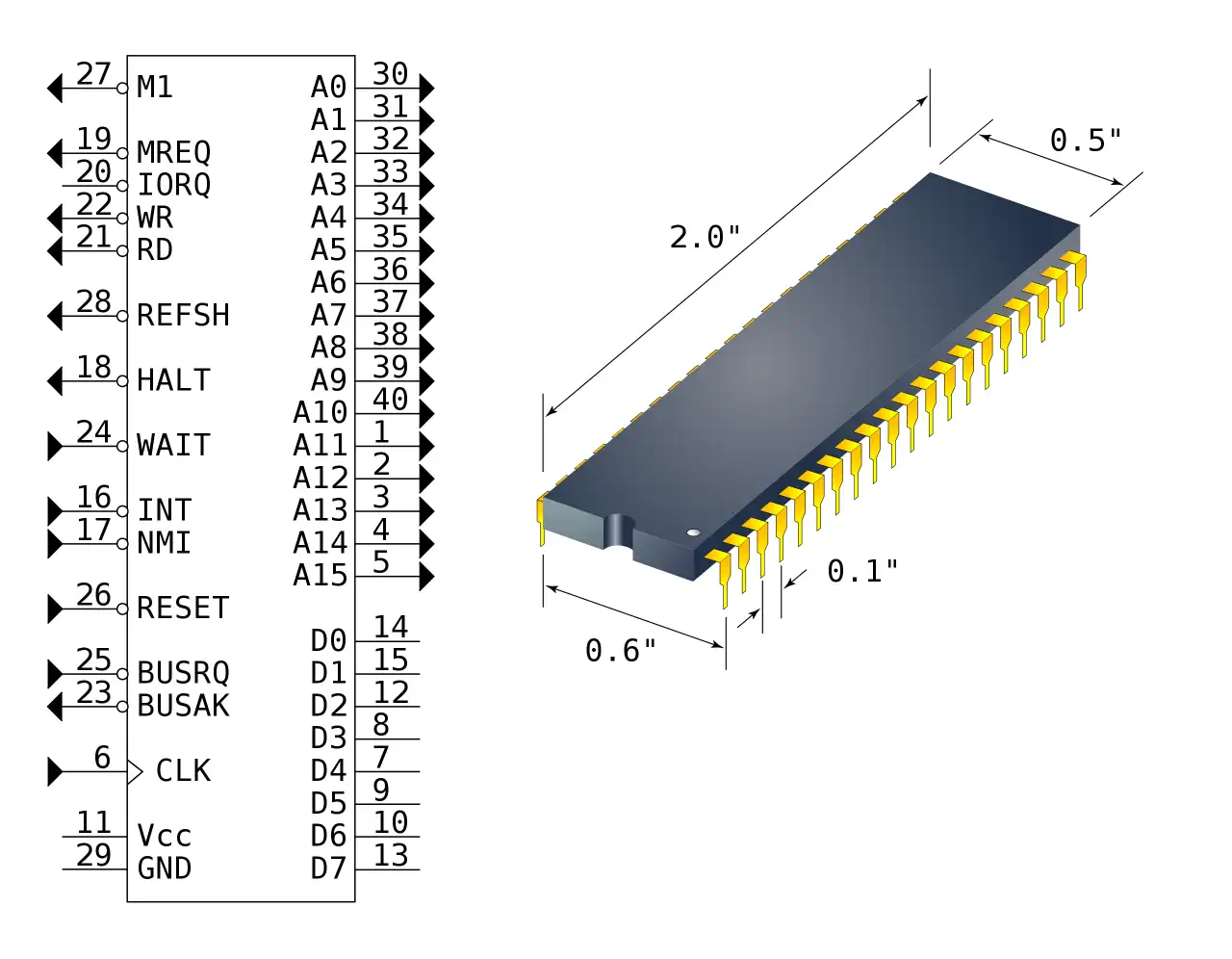
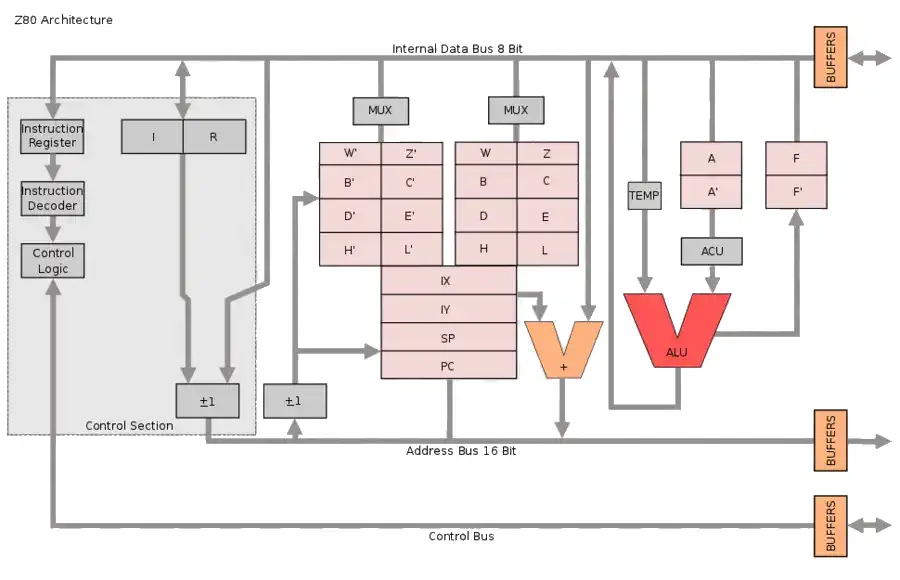
VRAM: 128kB Sound Chip Yamaha YM2149F Programmable Sound Generator Sound 3 wave channels + white noise Display Chip Yamaha V9938 VDP Display All MSX-1 modes
256x212 16 color
512x212 4 color
512x212 2 color
256x212 256 color Best Text 80x24 Best Color 256 simultaneous, or 16 out of 512 colors Best Graphics 512x424 interlaced Sprites 16 colors out of 512, 16x16, 8/scanline, 64 total System OS MSX 2 BIOS / MSX 2 BASIC Storage Internal Double sided sided 3.5" disk drive, external Tape, ROM cartridges

